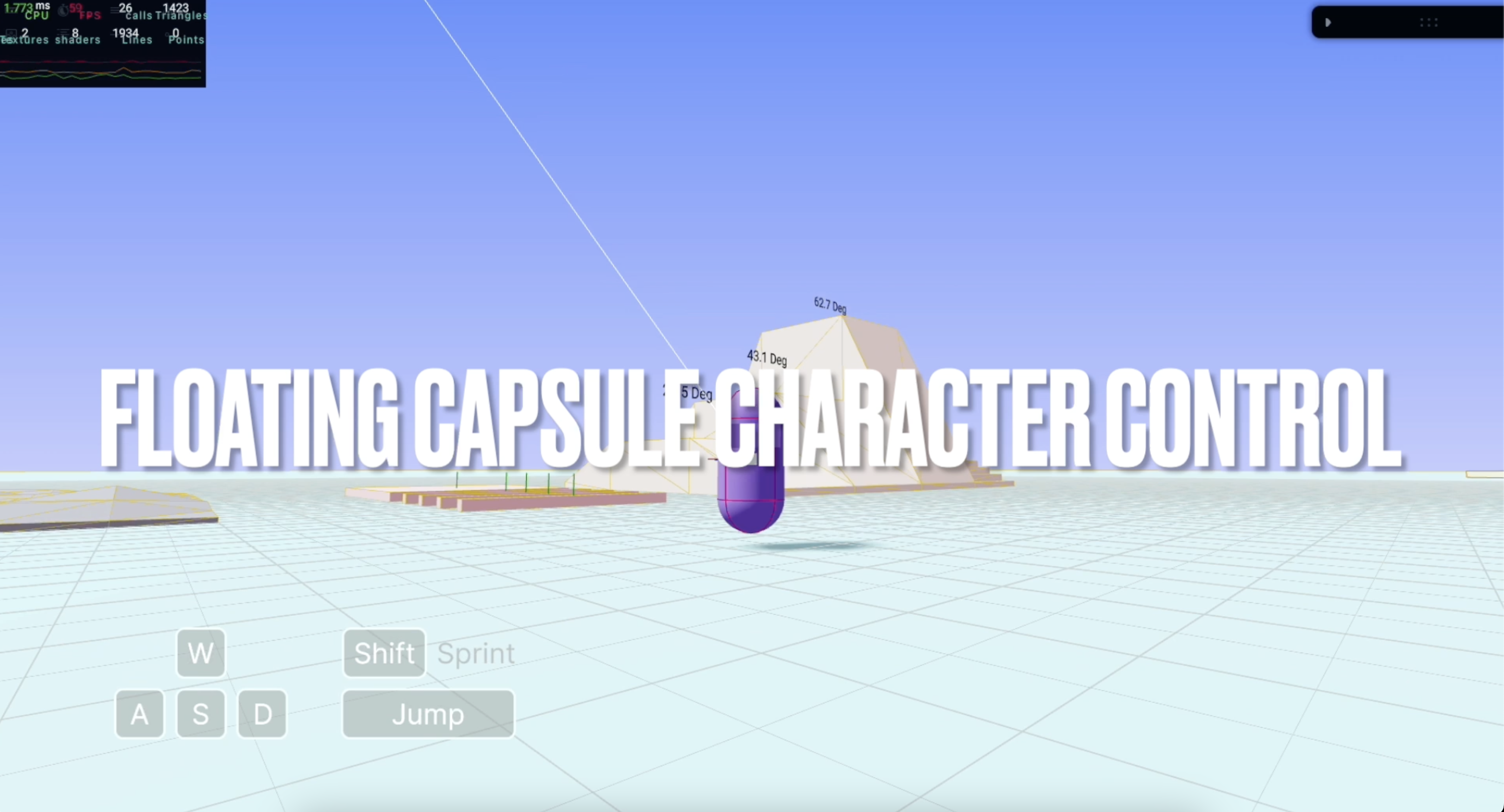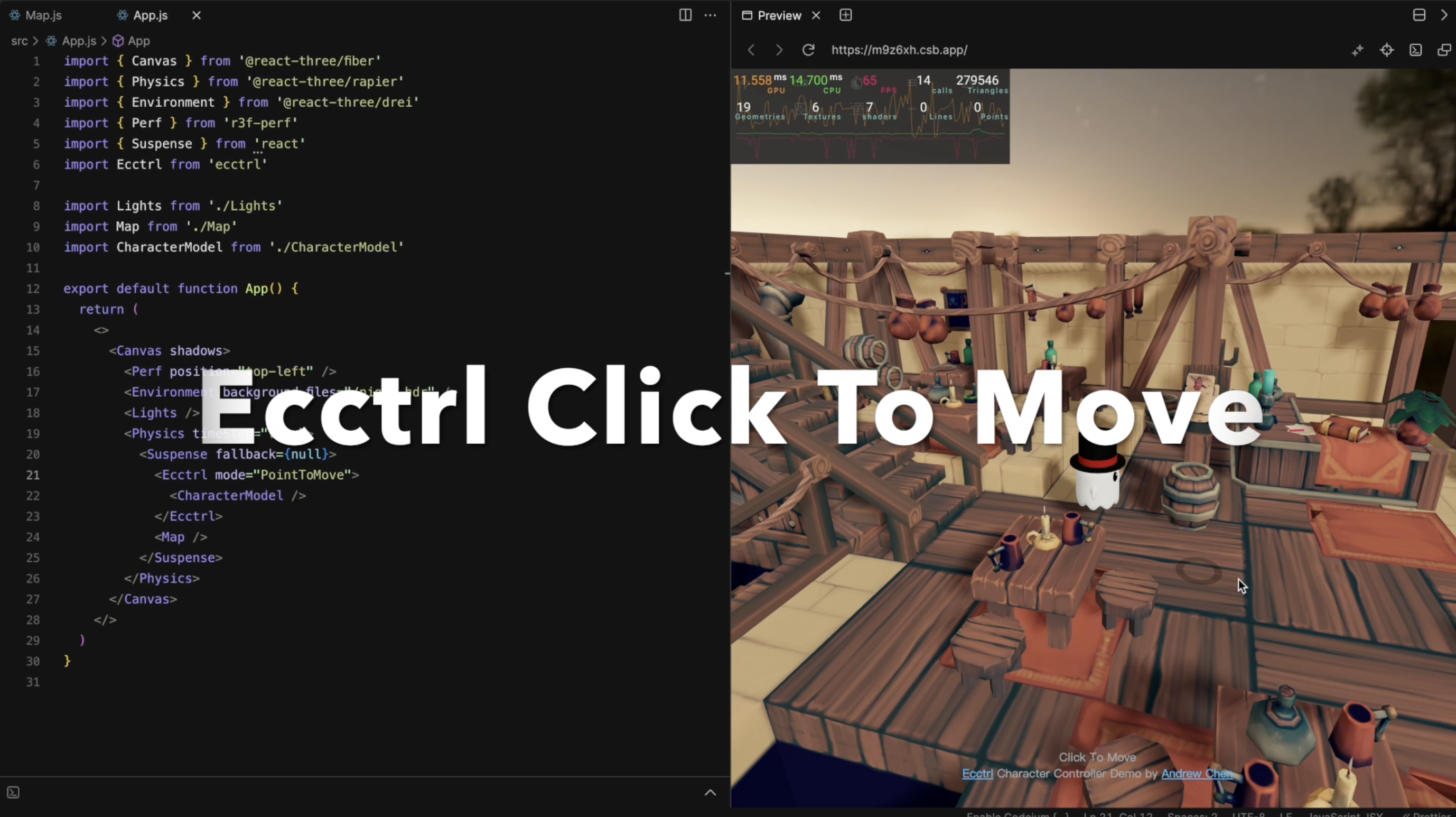Pmndrs/ecctrl is a simple web based character controller build on react-three-fiber and react-three-rapier. It provides a playground demo where you can experience the following features:
- Seamless movement over small obstacles
- Enhanced control with floating force incorporating spring and damping forces
- Rigidbody character functionality for interaction with the game environment
- Customizable ground friction for tailored control
- Realistic simulation with applied mass on supporting surfaces
- Smooth integration with moving and rotating platforms
- Now you can seamlessly switch between different modes by adding "mode" inside Ecctrl.
<Ecctrl mode="PointToMove">
- "PointToMove" mode is designed for click-to-move or path following features. (no needs for keyboard controls)
import { useGame } from 'ecctrl'
// ...
const setMoveToPoint = useGame((state) => state.setMoveToPoint)
// ...
// call function setMoveToPoint(), whenever character needs to move
setMoveToPoint(point) // "point" is a vec3 value - Here is a simple click-to-move example: Ecctrl CodeSandbox
Check out the featurelog.md for details on previous updates and features.
Live Demo: Floating Capsule Character Controller
Download Node.js. Run this followed commands:
# Install dependencies (only the first time)
npm install
# Run the local server at localhost:5173
npm run dev
# Build for production in the example/exampleDist/ directory
vite build -c vercelVite.config.jsBasic Controls (CodeSandbox Demo)
npm install ecctrlimport Ecctrl, { EcctrlAnimation } from "ecctrl";To get started, set up your keyboard map using KeyboardControls. Then, wrap your character model within <Ecctrl>:
/**
* Keyboard control preset
*/
const keyboardMap = [
{ name: "forward", keys: ["ArrowUp", "KeyW"] },
{ name: "backward", keys: ["ArrowDown", "KeyS"] },
{ name: "leftward", keys: ["ArrowLeft", "KeyA"] },
{ name: "rightward", keys: ["ArrowRight", "KeyD"] },
{ name: "jump", keys: ["Space"] },
{ name: "run", keys: ["Shift"] },
// Optional animation key map
{ name: "action1", keys: ["1"] },
{ name: "action2", keys: ["2"] },
{ name: "action3", keys: ["3"] },
{ name: "action4", keys: ["KeyF"] },
];
return (
<>
...
<Physics debug={physics} timeStep="vary">
{/* Keyboard preset */}
<KeyboardControls map={keyboardMap}>
{/* Character Control */}
<Ecctrl>
{/* Replace your model here */}
<CharacterModel />
</Ecctrl>
</KeyboardControls>
...
</Physics>
</>
);Here are all the default properties you can play with for <Ecctrl>:
// Default properties for Ecctrl
EcctrlProps: {
children, // ReactNode
debug: false, // Enable debug mode (require leva package)
capsuleHalfHeight: 0.35, // Half-height of the character capsule
capsuleRadius: 0.3, // Radius of the character capsule
floatHeight: 0.3, // Height of the character when floating
characterInitDir: 0, // Character initial facing direction (in rad)
followLight: false, // Enable follow light mode (name your light "followLight" before turn this on)
// Follow camera setups
camInitDis: -5, // Initial camera distance
camMaxDis: -7, // Maximum camera distance
camMinDis: -0.7, // Minimum camera distance
camInitDir: { x: 0, y: 0, z: 0 }, // Camera initial rotation direction (in rad)
camTargetPos: { x: 0, y: 0, z: 0 }, // Camera target position
camMoveSpeed: 1, // Camera moving speed multiplier
camZoomSpeed: 1, // Camera zooming speed multiplier
camCollision: true, // Camera collision active/deactive
camCollisionOffset: 0.7, // Camera collision offset
// Follow light setups
followLightPos: { x: 20, y: 30, z: 10 }, // Follow light position
// Base control setups
maxVelLimit: 2.5, // Maximum velocity limit
turnVelMultiplier: 0.2, // Turn velocity multiplier
turnSpeed: 15, // Turn speed
sprintMult: 2, // Sprint speed multiplier
jumpVel: 4, // Jump velocity
jumpForceToGroundMult: 5, // Jump force to ground object multiplier
slopJumpMult: 0.25, // Slope jump affect multiplier
sprintJumpMult: 1.2, // Sprint jump multiplier
airDragMultiplier: 0.2, // Air drag multiplier
dragDampingC: 0.15, // Drag damping coefficient
accDeltaTime: 8, // Acceleration delta time
rejectVelMult: 4, // Reject velocity multiplier
moveImpulsePointY: 0.5, // Move impulse point Y offset
camFollowMult: 11, // Camera follow speed multiplier
fallingGravityScale: 2.5, // Character is falling, apply higher gravity
fallingMaxVel: -20, // Limit character max falling velocity
wakeUpDelay: 200, // Wake up character delay time after window visibility change to visible (in ms)
// Floating Ray setups
rayOriginOffest: { x: 0, y: -capsuleHalfHeight, z: 0 }, // Ray origin offset
rayHitForgiveness: 0.1, // Ray hit forgiveness
rayLength: capsuleRadius + 2, // Ray length
rayDir: { x: 0, y: -1, z: 0 }, // Ray direction
floatingDis: capsuleRadius + floatHeight, // Floating distance
springK: 1.2, // Spring constant
dampingC: 0.08, // Damping coefficient
// Slope Ray setups
showSlopeRayOrigin: false, // Show slope ray origin
slopeMaxAngle: 1, // in rad, the max walkable slope angle
slopeRayOriginOffest: capsuleRadius - 0.03, // Slope ray origin offset
slopeRayLength: capsuleRadius + 3, // Slope ray length
slopeRayDir: { x: 0, y: -1, z: 0 }, // Slope ray direction
slopeUpExtraForce: 0.1, // Slope up extra force
slopeDownExtraForce: 0.2, // Slope down extra force
// AutoBalance Force setups
autoBalance: true, // Enable auto-balance
autoBalanceSpringK: 0.3, // Auto-balance spring constant
autoBalanceDampingC: 0.03, // Auto-balance damping coefficient
autoBalanceDampingOnY: 0.02, // Auto-balance damping on Y-axis
// Animation temporary setups
animated: false, // Enable animation
// Mode setups
mode: null, // Activate different ecctrl modes
// Other rigibody props from parent
// Rigidbody props can be used here,
// such as position, friction, gravityScale, etc.
...props
}
// Simply change the value by doing this
<Ecctrl maxVelLimit={5} jumpVel={4} position={[0,10,0]}>
<CharacterModel />
</Ecctrl>Apply Character Animations (CodeSandbox Demo)
If you want to apply character animations, prepare the character url and customize the animationSet with your own animation names. Change the Ecctrl property animated to true and wrap your character model inside <EcctrlAnimation> tag:
// Prepare character model url
const characterURL = "./ReplaceWithYourCharacterURL";
// Prepare and rename your character animations here
const animationSet = {
idle: "Idle",
walk: "Walk",
run: "Run",
jump: "Jump_Start",
jumpIdle: "Jump_Idle",
jumpLand: "Jump_Land",
fall: "Climbing", // This is for falling from high sky
// Currently support four additional animations
action1: "Wave",
action2: "Dance",
action3: "Cheer",
action4: "Attack(1h)", // This is special action which can be trigger while walking or running
};
return (
<>
...
<Physics debug={physics} timeStep="vary">
{/* Keyboard preset */}
<KeyboardControls map={keyboardMap}>
{/* Character Control */}
<Ecctrl animated>
{/* Character Animations */}
<EcctrlAnimation
characterURL={characterURL} // Must have property
animationSet={animationSet} // Must have property
>
{/* Replace your model here */}
<CharacterModel />
</EcctrlAnimation>
</Ecctrl>
</KeyboardControls>
...
</Physics>
</>
);For advanced animation setups, download all files and follow these steps:
- In
CharacterModel.jsx, expand theanimationSetwith additional animations:
// Rename your character animations here
const animationSet = {
idle: "Idle",
walk: "Walk",
run: "Run",
jump: "Jump_Start",
jumpIdle: "Jump_Idle",
jumpLand: "Jump_Land",
fall: "Climbing",
action1: "Wave",
action2: "Dance",
action3: "Cheer",
action4: "Attack(1h)",// This is special action which can be trigger while walking or running
//additinalAnimation: "additinalAnimationName",
};- In
useGame.jsx, create a trigger function for the new animation:
return {
/**
* Character animations state manegement
*/
// Initial animation
curAnimation: null,
animationSet: {},
...
action1: () => {
set((state) => {
if (state.curAnimation === state.animationSet.idle) {
return { curAnimation: state.animationSet.action1 };
}
return {};
});
},
/**
* Additional animations
*/
// triggerFunction: ()=>{
// set((state) => {
// return { curAnimation: state.animationSet.additionalAnimation };
// });
// }
};- In
CharacterController.jsx, initialize the trigger function and call it when needed:
// Animation change functions
const idleAnimation = useGame((state) => state.idle);
const walkAnimation = useGame((state) => state.walk);
const runAnimation = useGame((state) => state.run);
const jumpAnimation = useGame((state) => state.jump);
const jumpIdleAnimation = useGame((state) => state.jumpIdle);
const jumpLandAnimation = useGame((state) => state.jumpLand);
const fallAnimation = useGame((state) => state.fall);
const action1Animation = useGame((state) => state.action1);
const action2Animation = useGame((state) => state.action2);
const action3Animation = useGame((state) => state.action3);
const action4Animation = useGame((state) => state.action4);
//const additionalAnimation = useGame((state) => state.triggerFunction);To get start, simply import EcctrlJoystick from ecctrl
import { EcctrlJoystick } from "ecctrl";Place <EcctrlJoystick> outside of your canvas component, and you're done!
//...
<EcctrlJoystick />
<Canvas>
{/* ... */}
</Canvas>
//...You can also add lights or additional meshs like so (note: this will create components twice, once inside the joystick's scene, another inside the buttons' scene, so keep an eye on performance):
//...
<EcctrlJoystick>
<ambientLight />
<mesh>
<boxGeometry args={[1,1,1]} />
</mesh>
</EcctrlJoystick>
<Canvas>
{/* ... */}
</Canvas>
//...Additionally, you can change components' material, geometry, or texture as you like:
//...
<EcctrlJoystick
joystickBaseProps={{
receiveShadow: true,
material: new THREE.MeshStandardMaterial({ color: "grey" })
}}
/>
<Canvas>
{/* ... */}
</Canvas>
//...Here are all the properties you can play with for <EcctrlJoystick>:
EcctrlJoystickProps: {
// Joystick props
children?: ReactNode;
joystickPositionLeft?: number; // joystick div container position left
joystickPositionBottom?: number; // joystick div container position bottom
joystickHeightAndWidth?: number; // joystick div container height and width
joystickCamZoom?: number; // camera zoom level for the joystick
joystickCamPosition?: [x: number, y: number, z: number]; // camera position for the joystick
joystickBaseProps?: ThreeElements['mesh']; // custom properties for the joystick's base mesh
joystickStickProps?: ThreeElements['mesh']; // custom properties for the joystick's stick mesh
joystickHandleProps?: ThreeElements['mesh']; // custom properties for the joystick's handle mesh
// Touch buttons props
buttonNumber?: number; // Number of buttons (max 5)
buttonPositionRight?: number; // buttons div container position right
buttonPositionBottom?: number; // buttons div container position bottom
buttonHeightAndWidth?: number; // buttons div container height and width
buttonCamZoom?: number; // camera zoom level for the buttons
buttonCamPosition?: [x: number, y: number, z: number]; // camera position for the buttons
buttonGroup1Position?: [x: number, y: number, z: number]; // button 1 posiiton in 3D scene
buttonGroup2Position?: [x: number, y: number, z: number]; // button 2 posiiton in 3D scene
buttonGroup3Position?: [x: number, y: number, z: number]; // button 3 posiiton in 3D scene
buttonGroup4Position?: [x: number, y: number, z: number]; // button 4 posiiton in 3D scene
buttonGroup5Position?: [x: number, y: number, z: number]; // button 5 posiiton in 3D scene
buttonLargeBaseProps?: ThreeElements['mesh']; // custom properties for the buttons' large base mesh
buttonSmallBaseProps?: ThreeElements['mesh']; // custom properties for the buttons' small base mesh
buttonTop1Props?: ThreeElements['mesh']; // custom properties for the button 1 top mesh (large button)
buttonTop2Props?: ThreeElements['mesh']; // custom properties for the button 2 top mesh (large button)
buttonTop3Props?: ThreeElements['mesh']; // custom properties for the button 3 top mesh (small button)
buttonTop4Props?: ThreeElements['mesh']; // custom properties for the button 4 top mesh (small button)
buttonTop5Props?: ThreeElements['mesh']; // custom properties for the button 5 top mesh (small button)
};If you prefer to use your custom joystick or buttons, you can leverage the useJoystickControls hook from ecctrl. Import the hook and call the appropriate functions::
import { useJoystickControls } from "ecctrl";
//...
const setJoystick = useJoystickControls((state) => state.setJoystick);
const resetJoystick = useJoystickControls((state) => state.resetJoystick);
const pressButton1 = useJoystickControls((state) => state.pressButton1);
const releaseAllButtons = useJoystickControls(
(state) => state.releaseAllButtons
);
//...
// call the proper fuctions
setJoystick(joystickDis, joystickAng, runState);
// or
pressButton1();Activate different modes in Ecctrl by including the desired mode inside Ecctrl component:
<Ecctrl mode="PointToMove">.
1. "PointToMove" Mode (CodeSandbox Demo)
This mode doesn't require keyboard controls and is designed for click-to-move or path-following features.
import { useGame } from 'ecctrl'
// ...
const setMoveToPoint = useGame((state) => state.setMoveToPoint)
// ...
// call function setMoveToPoint(), whenever character needs to move
setMoveToPoint(point) // "point" is a vec3 value If you would like to quickly set up a first-person mode, you can modify these props to achieve that:
<Ecctrl
camInitDis={-0.01} // camera intial position
camMinDis={-0.01} // camera zoom in closest position
camFollowMult={100} // give any big number here, so the camera follows the character instantly
autoBalance={false} // turn off auto balance since it's not useful for the first-person view
>I appreciate your interest in this project! If you have any feedback, suggestions, or resources related to the controller, please feel free to share.
Thank you!

